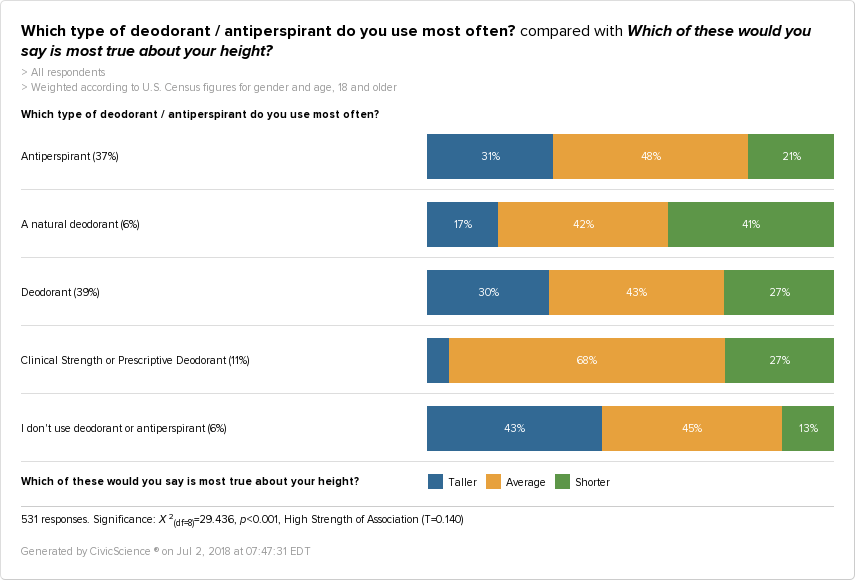The Gist: Antiperspirant and deodorant are the two most popular ways for US adults to battle sweat. Non-traditional deodorant options show interesting divides along generational and gender lines. And there may be a link between deodorant-wearing and self-perception.
It’s summer, at least in the Northern Hemisphere, which means that the sun is out, the temperatures are high, and many are feeling the heat. Fortunately, the body knows exactly how to cool things down, by sweating. And while it’s a helpful process, it can sometimes make for a smellier situation than you may have wanted.
So we got curious. Do you wonder what role deodorant plays in the scheme of things? Intrigued? Let’s get started.
Here, we can see that 39% of US adults are wearing antiperspirant. This is the same percentage as the US adults who are wearing traditional deodorant. These two more conventional options for battling sweat have the majority, indicating that most US adults are sticking to what they know. Natural deodorants, clinical strength deodorant and the no deodorant option have much smaller followings, firmly rooted in the periphery of the deodorant discussion.
But who exactly are these deodorant wearers? As it turns out, we can see some subtle shifts along age demographic lines.
If we look solely at antiperspirant and traditional deodorant (the first and third lines on the graph), we can see that Baby Boomers are far more likely to wear antiperspirant. Gen X-ers are almost evenly split between the two, while Millennials trend towards deodorant. While antiperspirant and deodorant may reveal subtle generational differences, the non-traditional categories are where we see the biggest divide. Clinical strength deodorant wearers are largely from the Millennial and Gen X crowd, while those who do not wear deodorant are either Millennials or Baby Boomers.
When we think about the reason for wearing deodorant, we may think that there’s a relationship to physical activity. But is that really the case?
It turns out; the answer may not be as straightforward as we thought. Here, we can see that 58% of US adults who wear deodorant do not exercise. And while 54% of antiperspirant wearers do exercise, this is not exactly an overwhelming majority.
In fact, in most categories, non-exercisers have a slight lead over-exercisers, thoroughly debunking the myth that deodorant is any more important to people who know they’re going to be actively sweating.
Of course, a look at deodorant would not be complete without a comparison to gender, as so much energy goes into marketing personal care products along binary lines.
As the data reveals, antiperspirant and deodorant wearers are almost equally men and women. However, the less mainstream options show a more gendered following. Natural deodorant and clinical strength wearers are generally female, while non-deodorant wearers skew slightly more male. This is information that should not be overlooked. Especially for companies with alternative deodorant products, it may be beneficial for marketing to appeal to a more female-friendly audience.
This discussion of deodorant leads us to contemplate the larger issues here, like the perception of overall attractiveness. Consider that women are much more likely to wear clinical strength or prescription deodorant–are they really sweating more, or is it the pressure to appear more attractive, and thus, sweat less? If the purpose of wearing deodorant or antiperspirant is not to smell, it would seem that those who do choose this path may care about their appearance or how they present themselves to the world.
When we compared our deodorant question to a question about physical attractiveness, this is what we found.
US adults who wear deodorant are the most likely to say that they are more physically attractive than most people their age and gender, with 40% indicating this. So, hiding sweat and feeling attractive may be somewhat connected, after all.
Since we know that height can also play a role in how we see ourselves, we wondered how it would impact the deodorant situation?
What we found is that the largest percentage of people who believe themselves to be tall also happen to not wear deodorant. It’s not exactly clear why this is. Perhaps it has something to do with self-confidence that not only makes deodorant unnecessary but also makes the individual feel taller? Perhaps it’s something else. But, whatever the cause, there is no denying the fact that this sort of perception gives us insight into the minds of consumers, potentially leading us to better understand the motivation behind a purchase.














